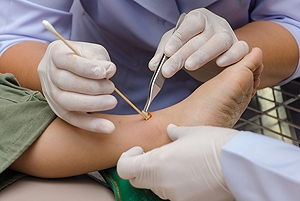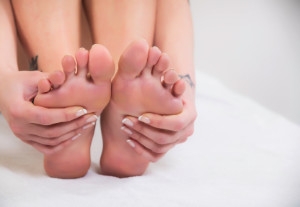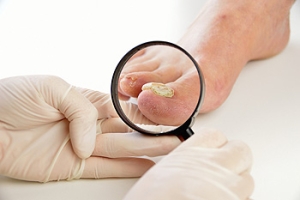
Caring for Diabetic Foot Ulcers
 We should all be wary of cuts, scrapes, and wounds on our feet, but diabetics need to be especially careful. Diabetic foot ulcers are open sores or wounds that form mainly on the bottoms of the feet of people with diabetes. These wounds are slow to heal and may become infected. Therefore, it is important for diabetics to take special care of their feet. Daily inspections of the feet to check for scrapes, sores, and blisters, can help detect any problems early on. If you find an open wound, wash it well with saline or clean tap water, then apply antibiotic ointment to the wound. Cover the wound with a bandage to protect it, and change the bandage every one to two days, making sure to clean and disinfect the wound again. Keep pressure off the wound as much as you can to aid in healing. If you have diabetes and struggle with diabetic foot ulcers, see a podiatrist who can help you take care of your feet.
We should all be wary of cuts, scrapes, and wounds on our feet, but diabetics need to be especially careful. Diabetic foot ulcers are open sores or wounds that form mainly on the bottoms of the feet of people with diabetes. These wounds are slow to heal and may become infected. Therefore, it is important for diabetics to take special care of their feet. Daily inspections of the feet to check for scrapes, sores, and blisters, can help detect any problems early on. If you find an open wound, wash it well with saline or clean tap water, then apply antibiotic ointment to the wound. Cover the wound with a bandage to protect it, and change the bandage every one to two days, making sure to clean and disinfect the wound again. Keep pressure off the wound as much as you can to aid in healing. If you have diabetes and struggle with diabetic foot ulcers, see a podiatrist who can help you take care of your feet.
Wound care is an important part in dealing with diabetes. If you have diabetes and a foot wound or would like more information about wound care for diabetics, consult with one of our podiatrists from Summit Podiatry. Our doctors will assess your condition and provide you with quality foot and ankle treatment.
What Is Wound Care?
Wound care is the practice of taking proper care of a wound. This can range from the smallest to the largest of wounds. While everyone can benefit from proper wound care, it is much more important for diabetics. Diabetics often suffer from poor blood circulation which causes wounds to heal much slower than they would in a non-diabetic.
What Is the Importance of Wound Care?
While it may not seem apparent with small ulcers on the foot, for diabetics, any size ulcer can become infected. Diabetics often also suffer from neuropathy, or nerve loss. This means they might not even feel when they have an ulcer on their foot. If the wound becomes severely infected, amputation may be necessary. Therefore, it is of the upmost importance to properly care for any and all foot wounds.
How to Care for Wounds
The best way to care for foot wounds is to prevent them. For diabetics, this means daily inspections of the feet for any signs of abnormalities or ulcers. It is also recommended to see a podiatrist several times a year for a foot inspection. If you do have an ulcer, run the wound under water to clear dirt from the wound; then apply antibiotic ointment to the wound and cover with a bandage. Bandages should be changed daily and keeping pressure off the wound is smart. It is advised to see a podiatrist, who can keep an eye on it.
If you have any questions, please feel free to contact one of our offices located in Wilmington, Whiteville, and Wallace, NC . We offer the newest diagnostic and treatment technologies for all your foot care needs.
Wound Care
Diabetics must be wary of all wounds, regardless of depth or size. Diabetes, a chronic disease in which the body cannot properly use glucose the way it normally would, causes various complications that make wounds difficult to heal. Nerve damage or neuropathy will cause diabetics to have trouble feeling the pain of a blister or cut until the condition has significantly worsened or become infected. A diabetic’s weakened immune system can make even the most minor of wounds easily susceptible to infection. Diabetics are also more prone to developing narrow, clogged arteries, and are therefore more likely to develop wounds.
Wounds should be taken care of immediately after discovery, as even the smallest of wounds can become infected if enough bacteria build up within the wound. To remove dirt, wounds should be first rinsed under running water only. Soap, hydrogen peroxide, or iodine can irritate the injury and should be avoided. To prevent infection, apply antibiotic ointment to the wound and cover it with a bandage. The bandage should be changed daily. The skin around the wound may be cleaned with soap.
To prevent further exacerbation, see a doctor—especially if you have diabetes. Minor skin conditions can become larger problems if not properly inspected. As the wound heals, make sure to avoid applying pressure to the affected area.
Foot Stretches for When You Work on Your Feet
 If you work on your feet, you may be familiar with the foot pain and soreness associated with standing all day. Stretching and exercising your feet can help relieve your pain and discomfort. Rolling a tennis ball under your feet can help reduce pain on your soles. For best results, remove your shoes and socks and sit on a chair. Press down lightly on the tennis ball with the bottoms of your feet as you roll it around. If you have ankle pain, you can relieve it by rolling your ankles in slow circles. You should feel a gentle stretch along your calves as the Achilles tendon is stretched. For more advice on how to relieve foot and ankle pain from working on your feet, speak with a podiatrist today.
If you work on your feet, you may be familiar with the foot pain and soreness associated with standing all day. Stretching and exercising your feet can help relieve your pain and discomfort. Rolling a tennis ball under your feet can help reduce pain on your soles. For best results, remove your shoes and socks and sit on a chair. Press down lightly on the tennis ball with the bottoms of your feet as you roll it around. If you have ankle pain, you can relieve it by rolling your ankles in slow circles. You should feel a gentle stretch along your calves as the Achilles tendon is stretched. For more advice on how to relieve foot and ankle pain from working on your feet, speak with a podiatrist today.
While working on the feet, it is important to take the proper care of them. For more information about working on your feet, contact one of our podiatrists from Summit Podiatry. Our doctors will treat your foot and ankle needs.
Working on Your Feet
Standing on your feet for long periods of time can cause stress and pain in your feet. Your whole body may experience change in terms of posture, back pain, bunions, callouses and or plantar warts. There are ways to avoid these conditions with proper foot care, smart choices and correct posture.
Positive Changes
Negative heeled shoe – Choosing this shoe type places the heel slightly lower than the ball of the foot. These are great for overall foot health. Find shoes that fit you correctly.
Go barefoot – Our feet were not designed to be enclosed for all hours of the day. Try to periodically expose your feet to air.
Eliminate Pain
Foot Exercises – Performing simple exercises, incorporating yoga and doing stretches are beneficial. This will allow increased blood flow to the area and muscles of the foot.
Achilles tendon – Stretching the foot out flat on the floor will relax the calf muscles and tendon. These exercises can be performed almost anywhere. Make sure you add these exercises to your daily regimen.
With a little bit of this information and knowing more about foot health, you will notice changes. Foot stretches and proper footwear will help with pain and prevent further issues.
If you have any questions please feel free to contact one of our offices located in Wilmington, Whiteville, and Wallace, NC . We offer the newest diagnostic and treatment technologies for all your foot and ankle needs.
Working on Your Feet
Foot care is important regardless of your profession, but those who work on their feet must pay special attention. Bunions, calluses, blisters, and plantar warts are just a few of the many conditions that can arise after standing all day. While painful at their worst, these conditions can easily be avoided with the right foot care. This includes both appropriate footwear and proper posture—important elements that affect the health of your feet.
Choosing appropriate footwear means choosing a shoe that has a negative heel. This means that the heel is slightly lower than the ball of your foot, which places less of a strain. If you have a profession that requires you to be on your feet all day, investing in a pair of high-quality shoes is pertinent. High-quality shoes can be purchased from a respected manufacturer that emphasizes foot care and foot health.
Despite the regularity of wearing shoes, the feet are naturally not designed to be enclosed. Regular “barefoot” time for your feet can be beneficial for foot health. Among other methods, allowing your feet to breathe can help alleviate the pain and pressure your feet may be experiencing from being on your feet all day.
Simple foot exercises and yoga positions can help improve both the health and function of your feet. Active foot exercises that create movement will stimulate your foot’s blood flow and circulation, and yoga positions that place your feet flat onto the floor will stretch out their muscles. Yoga is particularly beneficial for your Achilles tendon and calf muscles, which are areas that can become especially problematic if not taken care of. Foot exercises and yoga positions can be easily performed every day at virtually any location and any time; whether it is at the office, at the gym, or at home right before you go to bed. Simple stretching can increase your foot health by miles.
The foot pain you experience after lengthy hours working on your feet may seem inevitable and unavoidable; in reality, however, that is not the case. Wearing proper footwear and performing simple foot exercises and stretches can help ease foot pain and allow you to truly avoid frustrating foot problems.
Your feet can easily be kept healthy with some education and a little effort. Pain that begins at the feet can eventually affect the whole body. Begin taking care of your feet now!
What Treatments Are Available for Toenail Fungus?
 A fungal infection of the toenails is a very common condition that can cause the nails to become thickened, yellowed, or crumbly. This can sometimes lead to pain in the affected toenails. There are a variety of treatments available for fungal nail infections. Currently, a common treatment is an oral antifungal medication. While these medications have a high rate of curing the infection, it can take up to a year before you see visible results, and some people may experience side effects from taking the medication. Topical medications that are applied directly to the nail tend to have less side effects than oral medications, but are typically less effective. Some newer treatments, such as laser therapy, are still being studied, and have shown promising results thus far. If you have toenail fungus, it is recommended that you visit a podiatrist for treatment.
A fungal infection of the toenails is a very common condition that can cause the nails to become thickened, yellowed, or crumbly. This can sometimes lead to pain in the affected toenails. There are a variety of treatments available for fungal nail infections. Currently, a common treatment is an oral antifungal medication. While these medications have a high rate of curing the infection, it can take up to a year before you see visible results, and some people may experience side effects from taking the medication. Topical medications that are applied directly to the nail tend to have less side effects than oral medications, but are typically less effective. Some newer treatments, such as laser therapy, are still being studied, and have shown promising results thus far. If you have toenail fungus, it is recommended that you visit a podiatrist for treatment.
If left untreated, toenail fungus may spread to other toenails, skin, or even fingernails. If you suspect you have toenail fungus it is important to seek treatment right away. For more information about treatment, contact one of our podiatrists of Summit Podiatry. Our doctors can provide the care you need to keep you pain-free and on your feet.
Symptoms
- Warped or oddly shaped nails
- Yellowish nails
- Loose/separated nail
- Buildup of bits and pieces of nail fragments under the nail
- Brittle, broken, thickened nail
Treatment
If self-care strategies and over-the-counter medications does not help your fungus, your podiatrist may give you a prescription drug instead. Even if you find relief from your toenail fungus symptoms, you may experience a repeat infection in the future.
Prevention
In order to prevent getting toenail fungus in the future, you should always make sure to wash your feet with soap and water. After washing, it is important to dry your feet thoroughly especially in between the toes. When trimming your toenails, be sure to trim straight across instead of in a rounded shape. It is crucial not to cover up discolored nails with nail polish because that will prevent your nail from being able to “breathe”.
In some cases, surgical procedure may be needed to remove the toenail fungus. Consult with your podiatrist about the best treatment options for your case of toenail fungus.
If you have any questions, please feel free to contact one of our offices located in Wilmington, Whiteville, and Wallace, NC . We offer the newest diagnostic and treatment technologies for all your foot care needs.
Toenail Fungus
Toenail fungus is a frustrating problem that affects many people. It can be persistent and hard to get rid of. As many different types of fungi are present throughout the environment, it is very easy to contract toenail fungus.
The feet are especially susceptible to toenail fungus because shoes and socks create the ideal dark and moist environment that fungal infections thrive in. While fungal infections of the nail plate are quite common, if left untreated they can spread beyond the toenail and into the skin and other parts of the body.
Signs of toenail fungus include a thickened nail that has become yellow or brown in color, a foul smell, and debris beneath the nail. The toe may become painful due to the pressure of a thicker nail or the buildup of debris.
Treatment for toenail fungus is most effective during the early stages of an infection. If there is an accumulation of debris beneath the nail plate, an ingrown nail or a more serious infection can occur. While each treatment varies between patients, your podiatrist may prescribe you oral medications, topical liquids and creams, or laser therapy. To determine the best treatment process for you, be sure to visit your podiatrist at the first signs of toenail fungus.
What Issues Do Podiatrists Treat?
 A podiatrist is a doctor that is an expert in diagnosing and treating issues involving the feet and ankles. They can also prescribe medications and perform surgery. They may also work with other health care professionals to treat a variety of diseases that affect the foot. Any issue involving the bones, joints, muscles, skin, tissues, and nerves of the lower limbs can be treated by a podiatrist. These conditions can include arthritis, deformities, heel and arch pain, neuromas, sports injuries, diabetic foot issues, and skin and nail problems. For foot health education, prevention methods, or anyone who is experiencing any type of foot abnormality, seek the expertise of a podiatrist for a proper diagnosis and the best treatment plan.
A podiatrist is a doctor that is an expert in diagnosing and treating issues involving the feet and ankles. They can also prescribe medications and perform surgery. They may also work with other health care professionals to treat a variety of diseases that affect the foot. Any issue involving the bones, joints, muscles, skin, tissues, and nerves of the lower limbs can be treated by a podiatrist. These conditions can include arthritis, deformities, heel and arch pain, neuromas, sports injuries, diabetic foot issues, and skin and nail problems. For foot health education, prevention methods, or anyone who is experiencing any type of foot abnormality, seek the expertise of a podiatrist for a proper diagnosis and the best treatment plan.
If you are dealing with pain in your feet and ankles, you may want to seek help from a podiatrist. Feel free to contact one of our podiatrists from Summit Podiatry. Our doctors can provide the care you need to keep you pain-free and on your feet.
What Is a Podiatrist?
A podiatrist is a doctor of podiatric medicine who diagnoses and treats conditions of the foot, ankle, and related structures of the leg. Your podiatrist may specialize in a certain field such as sports medicine, wound care, pediatrics, and diabetic care. Podiatrists have the ability to become board certified through training, clinical experience, and then taking an exam.
What Do Podiatrists Do?
On a daily basis, a podiatrist may perform the following activities:
- Diagnose foot ailments such as ulcers, tumors, fractures, etc.
- Use innovative methods to treat conditions
- Use corrective orthotics, casts, and strappings to correct deformities
- Correct walking patterns and balance
- Provide individual consultations to patients
It is very important that you take care of your feet. It’s easy to take having healthy feet for granted, however foot problems tend to be among the most common health conditions. Podiatrists can help diagnose and treat a variety of feet related conditions, so it is crucial that you visit one if you need assistance.
If you have any questions please feel free to contact one of our offices located in Wilmington, Whiteville, and Wallace, NC . We offer the newest diagnostic and treatment technologies for all your foot and ankle needs.
What is a Podiatrist?
The branch of medicine that is focused on the treatment, diagnosis, and study of disorders of the lower leg, ankle and foot is referred to as podiatry. Because people often spend a great deal of their time on their feet, many problems in this area can occur. A person seeks help from the field of podiatry when they need treatment for heel spurs, bunions, arch problems, deformities, ingrown toenails, corns, foot and ankle problems, infections, and problems with the foot that are related to diabetes and additional diseases.
To treat problems of the foot, ankle or lower leg, a podiatrist may prescribe physical therapy, drugs, perform surgery, or set fractures. Individuals may also be recommended to wear corrective shoe inserts, custom-made shoes, plaster casts and strappings in order to correct deformities.
When trying to gather information on a patient problem, a scanner or force plate may be used in order to design orthotics. During this procedure, patients are told to walk across a plate that is connected to a computer; the computer then takes a scan of the foot and indicates weight distribution and pressure points. The computer readouts will give the podiatrist information to help them determine the correct treatment plans.
Diagnosis is also provided through laboratory tests and x-rays. Through the foot, the first signs of serious problems such as heart disease, diabetes and arthritis can show up. For example, individuals that have diabetes may frequently have problems such as infections and foot ulcers because they experience poor circulation in the foot area. A podiatrist can then have consultations with patients when symptoms arise. Referrals will then be made to specialists that handle the greater health problems.
Some podiatrists have their own independent, private practices or clinics where they have a small staff and administrative personnel. Many podiatrists work within group practices. They usually spend time performing surgery in ambulatory surgical centers or hospitals, or visit patients in nursing homes. Podiatrists typically spend between 30 to 60 hours of week working. Some podiatrists specialize in public health, orthopedics, surgery, or primary care. Other fields include specialties in geriatrics, dermatology, pediatrics, diabetic foot care and sports medicine.
Some podiatrist specialists complete extra training in the area of foot and ankle reconstruction that results from the effects of physical trauma or diabetes. There are also surgeons that perform surgery of a cosmetic nature to correct bunions and hammertoes.
Causes and Symptoms of Tarsal Tunnel Syndrome
 Tarsal tunnel syndrome occurs when there is a compression or squeezing of the posterior tibial nerve as it travels through the tarsal tunnel. The tarsal tunnel is a narrow space that lies on the inside of the ankle and it contains arteries, veins, tendons and nerves, including the tibial nerve. There can be a variety of causes for this compression such as an abnormal structure in the area, a cyst or bone spur, an injury that causes inflammation like an ankle sprain, and diseases like arthritis and diabetes. Those who have flat feet are also at a higher risk for tarsal tunnel syndrome because the heel tilts and can strain or stress to the nerve. Symptoms individuals experience consist of pain or numbness to the affected area, or a burning or tingling sensation which is often described similar to “pins and needles." Common treatment options for tarsal tunnel syndrome include orthotics, braces, rest, physical therapy, and in severe cases, surgery. If you are suffering from any symptom of tarsal tunnel syndrome it is important to visit a podiatrist for a proper diagnosis.
Tarsal tunnel syndrome occurs when there is a compression or squeezing of the posterior tibial nerve as it travels through the tarsal tunnel. The tarsal tunnel is a narrow space that lies on the inside of the ankle and it contains arteries, veins, tendons and nerves, including the tibial nerve. There can be a variety of causes for this compression such as an abnormal structure in the area, a cyst or bone spur, an injury that causes inflammation like an ankle sprain, and diseases like arthritis and diabetes. Those who have flat feet are also at a higher risk for tarsal tunnel syndrome because the heel tilts and can strain or stress to the nerve. Symptoms individuals experience consist of pain or numbness to the affected area, or a burning or tingling sensation which is often described similar to “pins and needles." Common treatment options for tarsal tunnel syndrome include orthotics, braces, rest, physical therapy, and in severe cases, surgery. If you are suffering from any symptom of tarsal tunnel syndrome it is important to visit a podiatrist for a proper diagnosis.
Tarsal tunnel syndrome can be very uncomfortable to live with. If you are experiencing tarsal tunnel syndrome, contact one of our podiatrists of Summit Podiatry. Our doctors can provide the care you need to keep you pain-free and on your feet.
Tarsal Tunnel Syndrome
Tarsal tunnel syndrome, which can also be called tibial nerve dysfunction, is an uncommon condition of misfiring peripheral nerves in the foot. The tibial nerve is the peripheral nerve in the leg responsible for sensation and movement of the foot and calf muscles. In tarsal tunnel syndrome, the tibial nerve is damaged, causing problems with movement and feeling in the foot of the affected leg.
Common Cause of Tarsal Tunnel Syndrome
- Involves pressure or an injury, direct pressure on the tibial nerve for an extended period of time, sometimes caused by other body structures close by or near the knee.
- Diseases that damage nerves, including diabetes, may cause tarsal tunnel syndrome.
- At times, tarsal tunnel syndrome can appear without an obvious cause in some cases.
The Effects of Tarsal Tunnel Syndrome
- Different sensations, an afflicted person may experience pain, tingling, burning or other unusual sensations in the foot of the affected leg.
- The foot muscles, toes and ankle become weaker, and curling your toes or flexing your foot can become difficult.
- If condition worsens, infections and ulcers may develop on the foot that is experiencing the syndrome.
A physical exam of the leg can help identify the presence of tarsal tunnel syndrome. Medical tests, such as a nerve biopsy, are also used to diagnose the condition. Patients may receive physical therapy and prescriptive medication. In extreme cases, some may require surgery.
If you have any questions please feel free to contact one of our offices located in Wilmington, Whiteville, and Wallace, NC . We offer the newest diagnostic and treatment technologies for all your foot and ankle needs.
Treating Tarsal Tunnel Syndrome
Tarsal tunnel syndrome is a condition in which the tibial nerve, located in the tarsal tunnel in the foot, is compressed. The tibial nerve can become compressed from injury, such as an ankle sprain, flat feet, and lesions. Arthritis, diabetes, and varicose veins can also cause swelling and thus result in nerve compression.
Symptoms of tarsal tunnel syndrome include several different sensations in the sole of the foot, inside the ankle, and around the tibial nerve. These sensations include shooting pains, numbness or reduced sensation, pins and needles, burning, and tingling. Symptoms tend to worsen with greater activity to the area. In rare and severe occasions, this can change the muscles in the foot.
If you suspect you have tarsal tunnel syndrome, you should consult with your podiatrist. He or she will examine your medical history to see if you have a history of diabetes, arthritis, or flat feet. They will also check to see if you have suffered an injury to the area recently. An electrical test will be conducted to check if the nerve has been damaged. A simpler Tinel’s Test might also be used. This includes simply tapping the nerve to create a sensation. An MRI scan of the area may also be used.
Treatments vary greatly for tarsal tunnel syndrome. Treatments include both nonsurgical and surgical options depending upon the severity of the condition. Nonsurgical options include anti-inflammatory medication and steroid injections to the area. Orthotics, such as a splint or brace that immobilizes the foot, is another noninvasive option. For those with flat feet, custom shoes can be made to offer better foot support. Surgical options include a tunnel tarsal release, in which an incision is made behind the ankle down to the arch of the foot. This releases the ligament and relieves pressure off the nerve. Some doctors use a more minimally invasive surgery, where smaller incisions are made in the ankle and the ligament is stretched out.
If you are suffering from painful sensations in your foot, see a podiatrist who can determine if you are experiencing tarsal tunnel syndrome. Tarsal tunnel syndrome that is left unchecked can cause permanent nerve damage to the foot.





